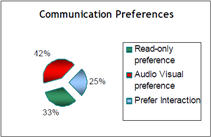A recent piece of research with one of the UK’s best 
known companies provided us with a fascinating statistic: that only one third of staff prefer to receive communication in a read-only form. Of the rest, over 40% prefer to receive it in an audio-visual form, whilst the remaining 25% want to interact with the content theyreceive by either discussing it locally with colleagues or more widely with other communities across the organisation. But despite this spread of preference, read-only remains the dominant form of internal communication. One of the most striking aspects of the research …

known companies provided us with a fascinating statistic: that only one third of staff prefer to receive communication in a read-only form. Of the rest, over 40% prefer to receive it in an audio-visual form, whilst the remaining 25% want to interact with the content theyreceive by either discussing it locally with colleagues or more widely with other communities across the organisation. But despite this spread of preference, read-only remains the dominant form of internal communication. One of the most striking aspects of the research …


 Hello, I'm Deborah Swallow and, for the last fifteen years, I've worked in over thirty countries addressing the complexities of people working internationally across multiple cultures, so individuals and organisations alike can gain an authentic competitive edge and win in international markets.
Hello, I'm Deborah Swallow and, for the last fifteen years, I've worked in over thirty countries addressing the complexities of people working internationally across multiple cultures, so individuals and organisations alike can gain an authentic competitive edge and win in international markets. 